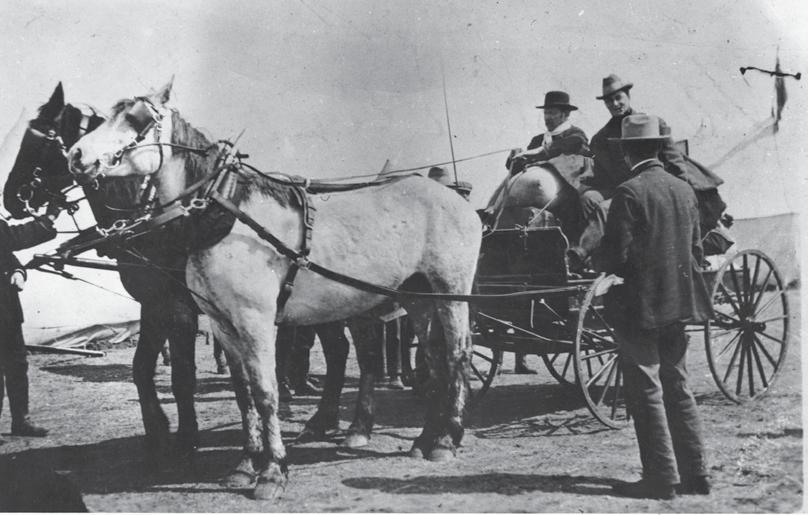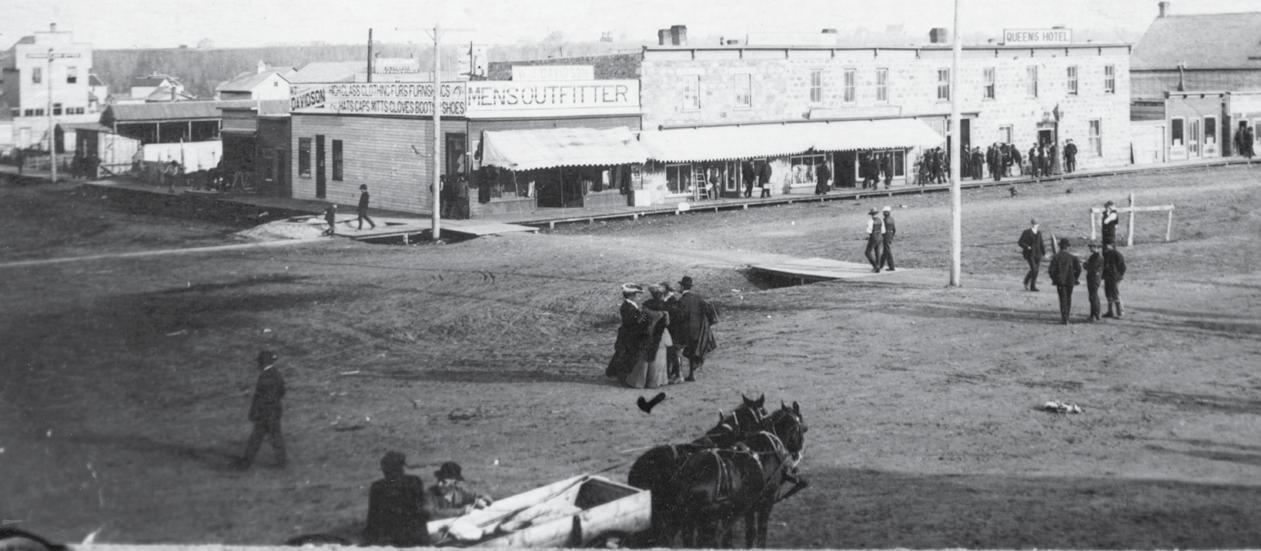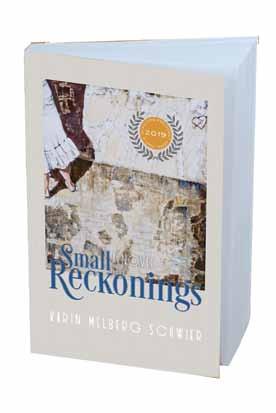
8 minute read
HOMEtown Reflections
The tents of "Canvas Town" with Immigration Hall in the background.
HOMEtown Reflections Jeff O’Brien The ba rr colonists Sa ska toon's first tourists
Advertisement
Tourism has always been hugely important to Saskatoon, even in 1903, when the Barr Colonists—the first really big tour group to hit the City of Bridges—got off the train here on their way to Lloydminster. They only stayed here a few days, but Saskatoon would never be the same again.
In 1902, Isaac Barr, an Ontario-born, Anglican minister living in England, conceived of a scheme to lead a party from England to plant the flag of Britain at the very edge of the Empire, in the far Canadian west. Barr called his new colony “Britannia” and he spoke passionately of a land of empty spaces
Photo Credit: Local History Room - Saskatoon Public Library - LH 2780
and endless riches, where the government was giving away hundreds of acres for the price of a ten-dollar filing fee, but which was starting to fill with immigrants from America and Central Europe. “Let us take possession of Canada!” he thundered. “Let our cry be ‘Canada for the British!’”
Trip West Plagued with Problems
Initially, Barr’s plans were quite modest, intended for a small party composed of people “of some means and an inclination for farming,” as one colonist later recalled. But the venture attracted huge interest and he was soon swamped with thousands of applications.
Rev. Isaac Barr holds the lines in a horse-drawn wagon.

They left England on March 31st, 1903. Barr had promised that every provision would be made to care for them both en route and when they arrived at their new
Photo Credit: Local History Room - Saskatoon Public Library - LH 4807
homes, including food, accommodation, hospitals and stores. Instead, things began to unravel almost right away.
The sea voyage was a nightmare, with nearly 2,000 seasick people crammed into a ship originally outfitted for 550. For the 1,400 travelling steerage, it was crowded and filthy. There was no privacy and the food was abysmal. Once in Canada, they were packed into noisy, uncomfortable, overcrowded trains for the long five-day trip to the end of the line, at Saskatoon.
Not Exactly the Answer to Prayers
They arrived here on the morning of April 17. It was the Promised Land, one young colonist would later recall: “When we get to Saskatoon! The words were on everybody’s lips. All our troubles would be over, all our problems solved, once we arrived at that magic town.” Sadly, Saskatoon did not live up to their expectations, being, instead little more than “a few houses huddled on one side of the [railway] track and a group of white tents, round and small, crouched on

Barr Colonists on board ship. Rev. Isaac Barr seated.

Photo Credit: Local History Room - Saskatoon Public Library - B 2099

the other side, and that was all.”
Saskatoon in those days consisted of about 400 people clustered along the railway tracks in what is now the downtown, a handful in what is now Riversdale, and a few dozen more in the old Temperance Colony town site across the river in Nutana, which you could only get to by taking the ferry or by walking across on the railway bridge, a practice that had become more complicated since they’d instituted daily train service the month before.

Some Creature Comforts
But it was not without amenities. There were general stores, a tinsmith, a butcher, a baker, a harness maker, a doctor, flour and lumber mills, a barber, insurance and real estate salesman, a bank, a number of modest houses and even two small hotels (with saloons!) across the street from the railway station. There was even a hall for concerts and public meetings. Indeed, there was a great deal more to Saskatoon than there had been only a couple of years before. But to a trainload of English city folk, it didn’t look like much of anything at all.
With their arrival, Saskatoon’s population q u a d r u p l e d . T h e r e were nowhere near accommodations enough for that many people. A few tents had been set up on the west side of the tracks near the Immigration Hall building. But most of their tents were stowed with their baggage, on a separate train that had yet to arrive. More cause for grumbling! When they did finally come,

Saloon at the Windsor Hotel in Saskatoon, 1903.

Photo Credit: Local History Room - Saskatoon Public Library - PH 96-80-16 Photo Credit: Local History Room - Saskatoon Public Library - PH 2004-5
“Canvas Town” as it was called, consisted of around 500-600 canvas tents pitched in an area from 21 st Street to the river.
Primitive Conditions
Conditions in the camp were terribly primitive, especially for urban dwellers unused to camp life. Canvas enclosures with a hole in the ground served as toilets, open to the sky and the chill spring breeze. Water was taken mostly from the river or from sloughs. The weather, as one might expect, varied from clear and chilly to cold and snowy, with a bit of rain thrown in for variety. It was as if Mother Nature was giving the new arrivals a taste of everything spring in Saskatchewan has to offer. Some of them were entranced by their temporary home, calling the

First Ave at 20th Street, 1903.

experience “one lovely picnic.” The rest were not so pleased.
Social distinctions in the camp mirrored those of home. The tents of the wellto-do were at the south end, closer to the river. “Here the men effect horsiness or sportiness of attire,” reported the newspaper. Dressed
Wagons of the Barr Colonists.
in “whipcord breeches or leather leggings with sombreros and ties that would wake the echoes, [they would] stroll around camp with setters and pointers at heel.” The ladies, meanwhile, put on their afternoon dresses and called upon each other for tea as if they were still back home.
Struggling to Adjust
Green as grass and completely clueless about life on the prairies, the new arrivals were the source of endless amusement for the locals. The literature is full of stories about how ill prepared they were for their new lives, everything from how to chop wood to how

to hitch and unhitch their animals or drive a cart. One writer recalls that it was quite common to see “a team and wagon bolting through the camp, sometimes with no driver, upsetting tents and scattering terrified colonists in all directions.”
For their part, and very much not to their credit,
Photo Credit: Local History Room - Saskatoon Public Library - C 180

some of the locals lined up to soak the newcomers for anything they could get, leading some of the colonists to nickname Saskatoon, “Sock-it-to-‘em.” This is a little ironic, since the greatest contribution of the Barr Colonists to Saskatoon was cash. Like tourists and travellers everywhere, they spent money like water. The local Board of Trade reported that the bank here cashed nearly $300,000 in drafts that April, most of which went to buy horses, oxen and cattle, wagons and ploughs, tools, provisions and supplies of every kind. The Barr Colonists brought with them all the clothes, books and pianos they could carry. In Saskatoon, they bought the things they would need to survive.
Ten Days Changed History
The Colonists stayed here for ten days while they got ready to take the long trail to their new homes, 200 miles to the west. Some changed their minds and stayed behind. Others only made it partway before turning around and coming back. At some point, grumblings about Barr’s leadership that had begun on the sea voyage flared into open revolt and the colonists voted to depose him in favour of Rev. George Exton Lloyd. Which is why we call it Lloydminster, not Barrview.
But those things all happened somewhere else. Here in Saskatoon, history had been made. The money the colonists spent was a huge boost to the local economy. Just as important, if not as easily measured, was the free advertising Saskatoon got in English and Canadian newspapers, which had followed Barr’s trek with great interest.
Partly as a result, Saskatoon would flower over the next few years, growing from a tiny village tucked into a sleepy corner along the South Saskatchewan River to become a major, modern, city.
Jeff O'Brien
Small Reckonings
Introducing a first novel by Karin Melberg Schwier
Winner of the 2019 John V. Hicks Award for Fiction
Already in its second printing
An intricately-told historical drama about the Burke family in Depression-era Saskatchewan when homesteaders scratched out a new existence on the prairie.

Author Karin Melberg Schwier

To Order:
Email the author directly - karin.schwier@mac.com Online - www.burtonhousebooks.com Call - (306) 586-2080





